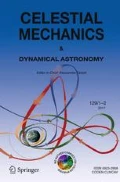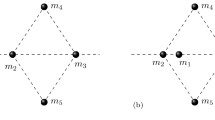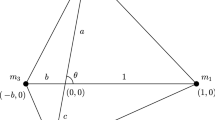Abstract
A complete solution is given for a symmetric case of the problem of the planar central configurations of four bodies, when two bodies are on an axis of symmetry, and the other two bodies have equal masses and are situated symmetrically with respect to the axis of symmetry. The positions of the bodies on the axis of symmetry are described by angle coordinates with respect to the outside bodies. The solution is such, that giving the angle coordinates, the masses for which the given configuration is a central configuration, can be computed from simple analytical expressions of the angles. The central configurations can be described as one-parameter families, and these are discussed in detail in one convex and two concave cases. The derived formulae represent exact analytical solutions of the four-body problem.



















Similar content being viewed by others
References
Albouy, A.: Symétrie des configurations centrales de quatre corps. C. R. Acad. Sci. Paris 320, 217–220 (1995)
Albouy, A.: The symmetric central configurations of four equal masses. Contemp. Math. 198, 131–136 (1996)
Albouy, A., Fu, Y., Sun, S.: Symmetry of planar four-body convex central configurations. Proc. R. Soc. A 464, 1355–1365 (2008)
Albouy, A., Cabral, H.E., Santos, A.A.: Some problems on the classical \(n\)-body problem. Celest. Mech. Dyn. Astron. 113, 369–375 (2012)
Albouy, A., Kaloshin, V.: Finiteness of central configurations of five bodies in the plane. Ann. Math. 176, 535–588 (2012)
Alvarez-Ramírez, M., Llibre, J.: The symmetric central configurations of the 4-body problem with masses \(m_1=m_2 \ne m_3=m_4\). Appl. Math. Comput. 219, 5996–6001 (2013)
Bernat, J., Llibre, J., Pérez-Chavela, E.: On the planar central configurations of the four-body problem with three equal masses. Math. Anal. 16, 1–13 (2009)
Corbera, M., Cors, J.M., Llibre, J.: On the central configurations of the planar \(1+3\) body problem. Celest. Mech. Dyn. Astron. 109, 27–43 (2011)
Cors, J.M., Roberts, G.E.: Four-body co-circular central configurations. Nonlinearity 25, 343–370 (2012)
Deng, C., Zhang, S.: Planar symmetric concave central configurations in Newtonian four-body problems. J. Geom. Phys. 83, 43–52 (2014)
Dziobek, O.: Über einen merkwürdigen Fall des Vielkörperproblems. Astron. Nach. 152, 33–46 (1900)
Hampton, M.: Splendid isolation: local uniqueness of the centered co-circular relative equilibria in the \(N\)-body problem. Celest. Mech. Dyn. Astr. 124, 145–153 (2016)
Hampton, M., Moeckel, R.: Finiteness of relative equilibria of the four-body problem. Invent. Math. 163, 289–312 (2006)
Leandro, E.S.G.: Finiteness and bifurcations of some symmetrical classes of central configurations. Arch. Ration. Mech. Anal. 167, 147–177 (2003)
Leandro, E.S.G.: On the central configurations of the planar restricted four-body problem. J. Differ. Equ. 226, 323–351 (2006)
Lehmann-Filhés, R.: Über zwei Fälle des Vielkörperproblems. Astron. Nach. 127, 137–143 (1891)
Long, Y., Sun, S.: Four-body central configurations with some equal masses. Arch. Ration. Mech. Anal. 162, 25–44 (2002)
MacMillan, W.D., Bartky, W.: Permanent configurations in the problem of four bodies. Trans. Am. Math. Soc. 34, 838–875 (1932)
Moulton, F.R.: The straight line solutions of the problem of \(n\) bodies. Ann. Math. 12, 1–17 (1910)
Perez-Chavela, E., Santoprete, M.: Convex four-body central configurations with some equal masses. Arch. Ration. Mech. Anal. 185, 481–494 (2007)
Piña, E., Lonngi, P.: Central configurations for the planar Newtonian four-body problem. Celest. Mech. Dyn. Astron. 108, 73–93 (2010)
Pizzetti, P.: Casi particolari del problema dei tre corpi. Rend. Real. Accad. Linc. 13, 17–26 (1904)
Saari, D.G.: Central configurations—a problem for the twenty-first century. Exped. Math. MAA Spectrum 283–295 (2011)
Shi, J., Xie, Z.: Classification of four-body central configurations with three equal masses. J. Math. Anal. Appl. 363, 512–524 (2010)
Smale, S.: Topology and mechanics. II. The planar \(n\)-body problem. Invent. Math. 11, 45–64 (1970)
Smale, S.: Mathematical problems for the next century. Math. Intell. 20, 7–15 (1998)
Szenkovits, F., Ureche, V.: On homographic solutions and central configurations of the \(n\)-body problem. Rom. Astron. J. 16, 167–175 (2006)
Sweatman, W.L.: Orbits near central configurations for four equal masses. Celest. Mech. Dyn. Astron. 119, 379–395 (2014)
Wintner, A.: The analytical foundations of celestial mechanics. Princeton University Press, Princeton, NJ (1941)
Xia, Z.: Convex central configurations for the \(n\)-body problem. J. Differ. Equ. 200, 185–190 (2004)
Xie, Z.: Inverse problem of central configurations and singular curve in the collinear \(4\)-body problem. Celest. Mech. Dyn. Astron. 107, 353–376 (2010)
Xie, Z.: Isosceles trapezoid central configurations of the Newtonian four-body problem. Proc. R. Soc. Edinb. A 142, 665–672 (2012)
Zhao, F., Chen, J.: Central configurations for \((pn+gn)\)-body problems. Celest. Mech. Dyn. Astron. 121, 101–106 (2015)
Acknowledgments
We thank the referees for useful suggestions.
Author information
Authors and Affiliations
Corresponding author
Appendix: The discriminant D
Appendix: The discriminant D
According to Eq. (82) and using Eqs. (78)–(80),
where
Thus
Rights and permissions
About this article
Cite this article
Érdi, B., Czirják, Z. Central configurations of four bodies with an axis of symmetry. Celest Mech Dyn Astr 125, 33–70 (2016). https://doi.org/10.1007/s10569-016-9672-5
Received:
Revised:
Accepted:
Published:
Issue Date:
DOI: https://doi.org/10.1007/s10569-016-9672-5




